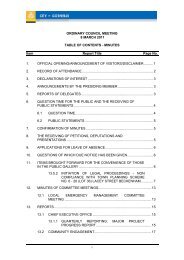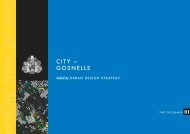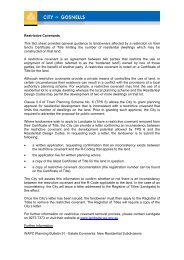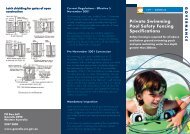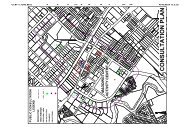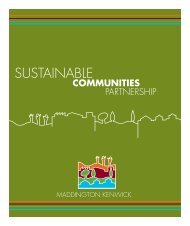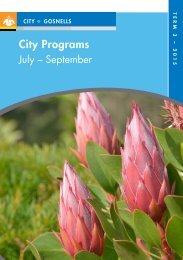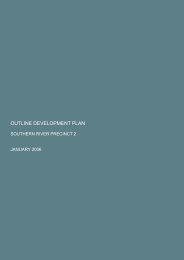Summary - City of Gosnells
Summary - City of Gosnells
Summary - City of Gosnells
Create successful ePaper yourself
Turn your PDF publications into a flip-book with our unique Google optimized e-Paper software.
Vegetation 522. Shrublands and Woodlands on Muchea Limestone <strong>of</strong> the Swan Coastal PlainMuchea Limestone (ML), a geological unit also known as Plain Limestone (Gozzard, 1982), occurs on theeastern side <strong>of</strong> the Swan Coastal Plain. It occurs in a discontinuous distribution from Muchea to Bengeralong the eastern side <strong>of</strong> the Swan Coastal Plain.The known occurrences <strong>of</strong> the Muchea Limestone TEC currently include a range <strong>of</strong> wetland and welldrainedplant habitats, on a variety <strong>of</strong> landforms. Unlike many other TECs, that are defined primarily on thebasis <strong>of</strong> floristic composition (e.g. a single Floristic Community Type from Gibson et al.,1994), the MucheaLimestone TEC is defined as a range <strong>of</strong> relatively heterogeneous assemblages that inhabits a rare geologicalformation. The vegetation that has been recorded on Muchea Limestone includes Melaleuca huegeliishrubland, Eucalyptus decipiens mallee, Casuarina obesa woodland and Melaleuca spp. (M. brevifolia, M.systena, or M. viminea) shrublands (Keighery and Keighery, 1995). Calcicole species such as Eremophilaglabra, Eucalyptus decipiens, Eucalyptus gomphocephala, Gahnia trifida, Grevillea curviloba, Grevilleaevanescens, Melaleuca brevifolia and Thysanotus arenarius can be present (Keighery and Keighery, 1995;English and Blyth, 2000b; B.J. Keighery, pers. comm.). Muchea Limestone vegetation was not sampled byGibson et al, (1994) and/or not identified as a distinct FCT in that study. Floristic analyses <strong>of</strong> vegetation <strong>of</strong>the eastern SCP that are conducted against the SCP database <strong>of</strong> Gibson et al, (1994) <strong>of</strong>ten group MLvegetation with the FCTs <strong>of</strong> Tamala Limestone in the Spearwood Dunes or FCT 18 (Shrublands onCalcareous Silts) due to the calicole species common to all <strong>of</strong> these vegetation types (English and Blyth,200b).The range <strong>of</strong> flora and vegetation that occurs in Muchea Limestone and the habitats <strong>of</strong> this TEC are, as yet,poorly documented. In addition to the generally high levels ( >90%) <strong>of</strong> loss and degradation <strong>of</strong> nativevegetation on the eastern SCP due to clearing and grazing(Government <strong>of</strong> Western Australian, 2000a, Table4, Pinjarra Plain), many occurrences <strong>of</strong> Muchea Limestone on the SCP have been extirpated by mining(Keighery and Keighery, 1995). There is little known about the aquifers that maintain this vegetation and thedevelopment <strong>of</strong> calcicole vegetation on the eastern SCP. There are no data available about the basiccharacteristics <strong>of</strong> these aquifers (e.g. fine scale maps <strong>of</strong> the aquifers or identification <strong>of</strong> the catchment areasthat maintain them) that could inform in the sustainable management <strong>of</strong> these ecosystems. The styg<strong>of</strong>aunathat potentially inhabit these aquifers have also not been investigated. Muchea Limestone and the biotaassociated with it are thus <strong>of</strong> high scientific and conservation significance.Muchea Limestone TEC occurrences are, as yet, poorly documented, but available data cite only twooccurrences south <strong>of</strong> the Swan River in the Perth Metropolitan Region. These are in BFS 465, SouthernRiver (Government <strong>of</strong> Western Australian, 2000) and in Cannington (; B.J. Keighery, pers. comm.).5.1.2 Vegetation <strong>of</strong> State Conservation SignificanceA search <strong>of</strong> the Threatened Ecological Communities Database <strong>of</strong> DEC (2008d) and searches <strong>of</strong> the literature(including Trudgen and Keighery, 1995 and Government <strong>of</strong> Western Australian, 2000) showed that, apartfrom the two EPBC listed TECS (as above), occurrences <strong>of</strong> another seven TECs that are listed by theWestern Australian Department <strong>of</strong> Environment and Conservation (Table 5.3) have been recorded inCannington, Forrestfield, Kenwick, Maddington, Orange Grove, Queens Park, Southern River, Welshpooland Wattle Grove. There were no Priority Threatened Ecological Communities (PTECs) listed by DEC(2008d) for this area.The seven TECS listed by DEC (2008d) have all been assessed and approved by the Western AustralianThreatened Species Scientific Committee, under the same international criteria that are used to determineTECS under the EPBC Act and thus they are, in a scientific sense, all <strong>of</strong> national conservation significance.However, these Western Australian-listed TECs are yet to be endorsed by the Federal Department <strong>of</strong>Environment, Water, Heritage and the Arts for EPBC listing.Tauss, C. and Weston, A.S. (2010). The flora, vegetation and wetlands <strong>of</strong> the Maddington-Kenwick Strategic Employment Area.A survey <strong>of</strong> the rural lands in the vicinity <strong>of</strong> the Greater Brixton Street Wetlands. Report to the <strong>City</strong> <strong>of</strong> <strong>Gosnells</strong>, W.A. Version 18.04.10



